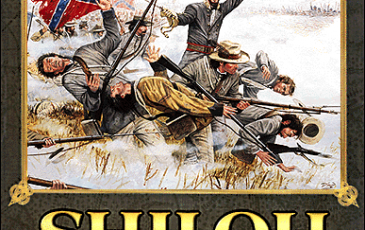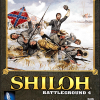13 Mar 62, Spring River, Ak - Battleground 4: Shiloh

| Rating: | 0 (0) |
| Games Played: | 0 |
| SM: | 3 |
| Turns: | 12 |
| Type: | Custom |
| First Side: | Union |
| Second Side: | CSA |
| Downloads: | 365 |
13 March 1862, Spring River, Ak [Curt Cabbage]
The largest Civil War engagement in Fulton County, the Action at Spring River occurred when Union forces from Missouri ventured into north-central Arkansas in search of Confederate cavalry bands seeking to unite as a regiment. Fought over the space of four hours, the battle resulted in the temporary elimination of a Confederate presence in southern Missouri, as well as sixteen Union and well over 100 Confederate casualties.
Lieutenant Colonel. Samuel N. Wood of the Sixth Missouri Cavalry Regiment led a force of 250 troopers of his regiment and 130 men of the Third Iowa Cavalry led by Major William C. Drake south from Missouri on March 10, 1862. They were in pursuit of Confederate troops commanded by Colonel W.O. Coleman, J. Posey Woodside and Colonel Archibald MacFarlane, who were seeking to consolidate their bands into a single regiment of 600 to 1,000 men.
The Union force entered Arkansas at Spring River Mill on March 12 and there engaged a squad of Coleman’s Confederates, killing two and wounding four before camping for the night, having driven the Confederates away. At daylight on March 13, Wood’s troops continued toward Salem (Fulton County), chasing away Rebel pickets and passing through a hastily abandoned camp on their way. The Yankee expedition collided with the combined Confederate force, which Wood estimated at 600 to 1,000 men, at a swampy area northeast of Salem.
Wood ordered his single cannon to begin firing on the Confederate position, sent Drake’s Iowans to the north of the swamp, and began a general advance from the south. The Rebel cavalrymen opened fire, killing and wounding several of Wood’s Missouri troopers, and then attempted to retreat only to be hit by Drake’s men, who drove them back into the swamp. The Federal troops were unable to pursue the Confederates into the swamp, given their lack of ammunition and a scarcity of rifles among the Iowans, who were primarily armed with pistols.
The Confederates were reinforced by approximately 250 men from Salem and advanced from the swamp as Wood loaded his dead and wounded men onto wagons for removal from the field. The Union commander detailed one in four of his men to hold horses, armed the others with every carbine available, and charged the approaching Confederates. The Rebels were driven back into the swamp, and Wood retreated back into Missouri. The entire action lasted about four hours.
Union casualties comprised four killed, eighteen wounded and one missing, for a total of twenty-three. Confederate losses were unreported, but Wood estimated them at a minimum of 100. Wood credited the action at Spring River with clearing southern Missouri, at least for a time, of Confederate troops. The adjutant of the Third Iowa deemed the fight “one of the hardest contested engagements of its size in the West.”
The largest Civil War engagement in Fulton County, the Action at Spring River occurred when Union forces from Missouri ventured into north-central Arkansas in search of Confederate cavalry bands seeking to unite as a regiment. Fought over the space of four hours, the battle resulted in the temporary elimination of a Confederate presence in southern Missouri, as well as sixteen Union and well over 100 Confederate casualties.
Lieutenant Colonel. Samuel N. Wood of the Sixth Missouri Cavalry Regiment led a force of 250 troopers of his regiment and 130 men of the Third Iowa Cavalry led by Major William C. Drake south from Missouri on March 10, 1862. They were in pursuit of Confederate troops commanded by Colonel W.O. Coleman, J. Posey Woodside and Colonel Archibald MacFarlane, who were seeking to consolidate their bands into a single regiment of 600 to 1,000 men.
The Union force entered Arkansas at Spring River Mill on March 12 and there engaged a squad of Coleman’s Confederates, killing two and wounding four before camping for the night, having driven the Confederates away. At daylight on March 13, Wood’s troops continued toward Salem (Fulton County), chasing away Rebel pickets and passing through a hastily abandoned camp on their way. The Yankee expedition collided with the combined Confederate force, which Wood estimated at 600 to 1,000 men, at a swampy area northeast of Salem.
Wood ordered his single cannon to begin firing on the Confederate position, sent Drake’s Iowans to the north of the swamp, and began a general advance from the south. The Rebel cavalrymen opened fire, killing and wounding several of Wood’s Missouri troopers, and then attempted to retreat only to be hit by Drake’s men, who drove them back into the swamp. The Federal troops were unable to pursue the Confederates into the swamp, given their lack of ammunition and a scarcity of rifles among the Iowans, who were primarily armed with pistols.
The Confederates were reinforced by approximately 250 men from Salem and advanced from the swamp as Wood loaded his dead and wounded men onto wagons for removal from the field. The Union commander detailed one in four of his men to hold horses, armed the others with every carbine available, and charged the approaching Confederates. The Rebels were driven back into the swamp, and Wood retreated back into Missouri. The entire action lasted about four hours.
Union casualties comprised four killed, eighteen wounded and one missing, for a total of twenty-three. Confederate losses were unreported, but Wood estimated them at a minimum of 100. Wood credited the action at Spring River with clearing southern Missouri, at least for a time, of Confederate troops. The adjutant of the Third Iowa deemed the fight “one of the hardest contested engagements of its size in the West.”























